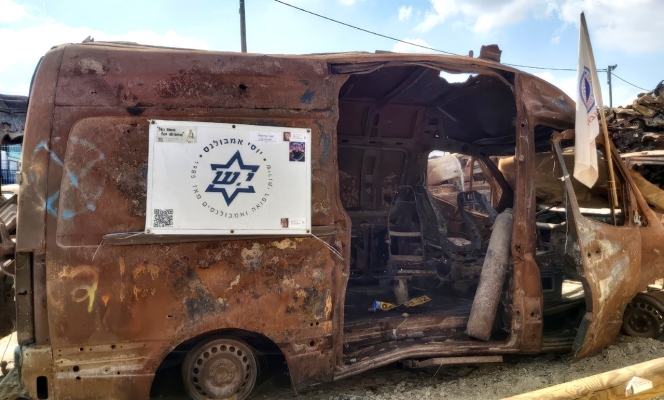A Compound of Hell: October's Wrecked Vehicles
 The YIZKOR memorial in the center of the burnt vehicles compound and right, two ambulances that were attacked and destroyed by Hamas terrorists
The YIZKOR memorial in the center of the burnt vehicles compound and right, two ambulances that were attacked and destroyed by Hamas terrorists
Photos & Text: Lydia Aisenberg
On the opposite side of a narrow road leading to a citrus orchard belonging to Tkuma, a moshav situated a short distance from the north-western Negev town of Netivot, and a handful of kilometers from the Gaza border , the grisly remains of 1,560 cars, vans, ambulances and other modes of transport are visible.
They are stacked in the main along the perimeter of what was – until last year's 7th of October– a wheat field. The site has become a collection point for destroyed vehicles, to collect from the roadside in order to free up the highways for access by security forces, but also to allow each vehicle to be scrupulously searched for human remains and any retrievable belongings of its former occupants.
The vehicles are piled five or six high. Rays of sunshine, forcing their way between large and small gaps in and between the towers of twisted metal, form weird shaped shadows on the ground as they appear to stretch out toward a large white rock, having YIZKOR in bold metallic Hebrew letters affixed to its center.
Alongside the rock stands a small burned-out car, but still almost keeping its shape, with hundreds of ceramic anemonies pouring from the driver's and passengers' seats out of the gaping back window, then down the car's boot to the ground and onward, eventually curling around the base of the YIZKOR remembrance rock.
In the center of the now dry dusty field sit three or four rows of what can still be recognized as private and commercial vehicles – but only just.They are also extremely damaged, peppered like a sieve with bullet holes, doors hanging on a single hinge or blown off – but not burned-out shells like those stacked on high.
One can make out not only the type and make of car, but also its color and in most cases, at least one of the number plates is intact.
A damaged tractor and small battery-operated 3-wheeled cart, generally associated with used by the elderly or infirm, lopsidedly languish side by side in a separate area – almost like a defiant middle finger pointed to the Hamas terrorists who sought to destroy everybody and everything along their way as they turned a quiet Shabbat morning into a barbaric frenzy of murder and destruction.
Silence permeates the air above the stomach-churning sight of the remains of the hundreds of vehicles mostly burned, grotesquely twisted and barely recognizable along the route taken by hundreds of Israelis – the majority attempting to flee the Nova music festival and its environs. So many had lost their lives as Hamas terrorists riddled their cars with machine gun fire or rocket propelled grenades (RPGs)caused their vehicles to burst into flames.
The silence of the compound, where not a single bird can be seen or heard, becomes absolutely deafening as one begins to realize the enormity of the tragedy that befell the drivers and their passengers, those Israelis and non-Israelis, who perished on that Black Shabbat.
On the day I was there, an official local moshav, resident cumguide explained why she did not want to be identified, by stating that she was there to tell the stories of the victims and not her own. She explained that the burnt vehicles compound, as it has become known, consists of hundreds of vehicles that were cleared from the Israel-Gaza border area roads and communities in the weeks following the terrorist attack.
"The compound was originally established as a logistical solution, providing somewhere for the vehicles to be evacuated to in order to clear the region's roads and ensure they remained clear, allowing the military forces operational movement and, of course, for us to also be able to get around"..
"The vehicles evacuation was organized by officers and soldiers of the Home Front Command and coordinated with the National Roads Authority and more.
"All vehicles needed to be meticulously listed, searched for hazardous devices, such as unexploded munitions or anything that could harm those handling the vehicles, and of course, the all important task of collecting victims' remains to ensure they could be brought to proper burial.
"There was also great effort in gathering and listing the huge amounts of personal belongings retrieved either from vehicles or discarded at the roadside.
"Behind every vehicle there are stories involving families, children, parents, adults and young people, and the geographical area in the country where they had come from. We listen to the grieving families and friends when they come here and some remarkable deep relationships have formed between those of us who have taken on the task of making sure the site maintains the appropriate honor and respect.
"There are so many tragic stories, but also stories of sheer heroism – in some cases shown by total strangers who succeeded in saving others before they themselves were murdered.
"Many families and friends of those who died come to this compound, spend time here and share more and more anecdotes about their loved ones and possibly about friends who perished with them.
"It is truly heartbreaking. We have now become so much part of their grieving process. We have now become the carriers of their stories, to pass on to keep alive – we've become so much part of their grieving process and it is an honor to pass on," she concluded.








Comments